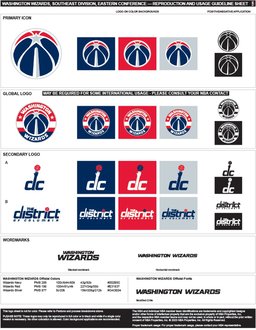Washington Wizards
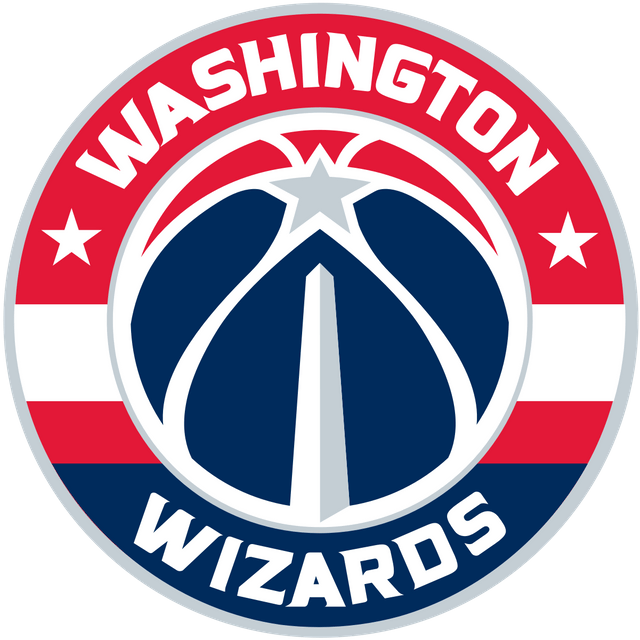
Washington Wizards

| Washington Wizards | ||||
|---|---|---|---|---|
| ||||
| Conference | Eastern | |||
| Division | Southeast | |||
| Founded | 1961 | |||
| History | Chicago Packers 1961–1962 Chicago Zephyrs 1962–1963 Baltimore Bullets 1963–1973 Capital Bullets 1973–1974 Washington Bullets 1974–1997 Washington Wizards 1997–present[1][2][3] | |||
| Arena | Capital One Arena | |||
| Location | Washington, D.C. | |||
| Team colors | Red, navy blue, silver, white[4][5] | |||
| Main sponsor | GEICO[6] | |||
| General manager | Tommy Sheppard | |||
| Head coach | Scott Brooks | |||
| Ownership | Monumental Sports & Entertainment | |||
| Affiliation(s) | Capital City Go-Go | |||
| Championships | 2 (1948, 1978) | |||
| Conference titles | 4 (1971, 1975, 1978, 1979) | |||
| Division titles | 7 (1971, 1972, 1973, 1974, 1975, 1979, 2017) | |||
| Retired numbers | 5 (10, 11, 25, 41, 45) | |||
| Website | www.nba.com/wizards [77] | |||
| ||||
The Washington Wizards are an American professional basketball team based in Washington, D.C. The Wizards compete in the National Basketball Association (NBA) as a member of the league's Eastern Conference Southeast Division. The team plays its home games at the Capital One Arena, in the Chinatown neighborhood of Washington, D.C.
The franchise was established in 1961 as the Chicago Packers based in Chicago, Illinois, and were renamed to Chicago Zephyrs the following season. In 1963, they relocated to Baltimore, Maryland and became the Baltimore Bullets, taking the name from a previous team of the same name. In 1973, the team changed its name to the Capital Bullets to reflect their move to the Washington metropolitan area, and then to Washington Bullets in the following season. In 1997, they rebranded themselves as the Wizards.
The Wizards have appeared in four NBA Finals, and won in 1978. They have had a total of 28 playoff appearances, won four conference titles (1971, 1975, 1978, 1979), and seven division titles (1971, 1972, 1973, 1974, 1975, 1979, 2017). Their best season came in 1975 with a record of 60–22. Wes Unseld is the only player in franchise history to become the MVP (1969), and win the Finals MVP award (1978). Four players (Walt Bellamy, Terry Dischinger, Earl Monroe and Wes Unseld) have won the Rookie of the Year award.
| Washington Wizards | ||||
|---|---|---|---|---|
| ||||
| Conference | Eastern | |||
| Division | Southeast | |||
| Founded | 1961 | |||
| History | Chicago Packers 1961–1962 Chicago Zephyrs 1962–1963 Baltimore Bullets 1963–1973 Capital Bullets 1973–1974 Washington Bullets 1974–1997 Washington Wizards 1997–present[1][2][3] | |||
| Arena | Capital One Arena | |||
| Location | Washington, D.C. | |||
| Team colors | Red, navy blue, silver, white[4][5] | |||
| Main sponsor | GEICO[6] | |||
| General manager | Tommy Sheppard | |||
| Head coach | Scott Brooks | |||
| Ownership | Monumental Sports & Entertainment | |||
| Affiliation(s) | Capital City Go-Go | |||
| Championships | 2 (1948, 1978) | |||
| Conference titles | 4 (1971, 1975, 1978, 1979) | |||
| Division titles | 7 (1971, 1972, 1973, 1974, 1975, 1979, 2017) | |||
| Retired numbers | 5 (10, 11, 25, 41, 45) | |||
| Website | www.nba.com/wizards [77] | |||
| ||||
Franchise history
Team creation
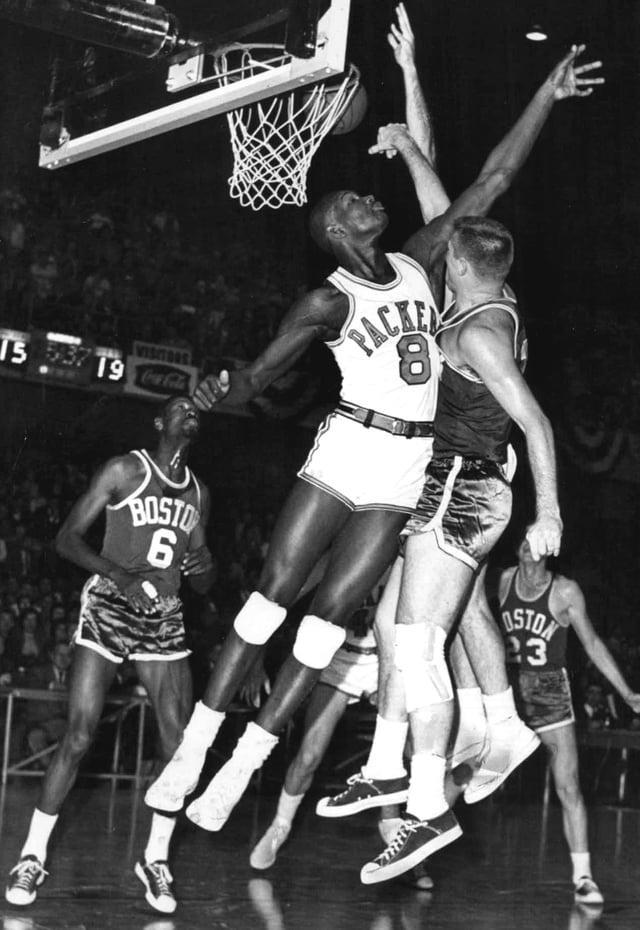
Bellamy (#8) averaged 31.6 points per game and 19.0 rebounds per game during his rookie season.
The team now known as the Wizards began playing as the Chicago Packers in 1961, as the first modern expansion team in NBA history, an expansion prompted by Abe Saperstein's American Basketball League. Rookie Walt Bellamy was the team's star, averaging 31.6 points per game, 19.0 rebounds per game, and leading the NBA in field goal percentage. During the All-Star game, Bellamy represented the team while scoring 23 points and grabbing 17 rebounds. Bellamy was named the league Rookie of the Year, but the team finished with the NBA's worst record at 18-62.
The team's original nickname was a nod to Chicago's meatpacking industry; their home arena, the International Amphitheater, was next door to the Union Stock Yards. However, it was extremely unpopular since it was the same nickname used by the NFL's Green Bay Packers, bitter rivals of the Chicago Bears. After only one year, the organization changed its name to the Chicago Zephyrs and played its home games at the Chicago Coliseum (Saperstein's ABL Majors prevented the team from playing in the larger Chicago Stadium). Their only season as the Zephyrs boasted former Purdue star Terry Dischinger, who went on to win Rookie of the Year honors. In 1963 the franchise moved to Baltimore, Maryland, and became the Baltimore Bullets, taking their name from a 1940s–'50s Baltimore Bullets BAA/NBA franchise and playing home games at the Baltimore Civic Center (the NBA would return to Chicago in 1966 when the Chicago Bulls began play). In their first year in Baltimore, the Bullets finished fourth in a five–team Western Division.[7]
Prior to the 1964–65 NBA season the Bullets pulled off a blockbuster trade, sending Dischinger, Rod Thorn and Don Kojis to the Detroit Pistons for Bailey Howell, Don Ohl, Bob Ferry and Wali Jones. The trade worked out well; Howell proved to be a hustler and a fundamentally sound player. He helped the Bullets get into the playoffs for the first time in franchise history. In the 1965 NBA Playoffs, the Bullets stunned the St. Louis Hawks 3–1, and advanced to the Western Conference finals. In the finals, Baltimore managed to split the first four games with the Los Angeles Lakers before losing the series 4–2.
1967–1981: The Wes Unseld era
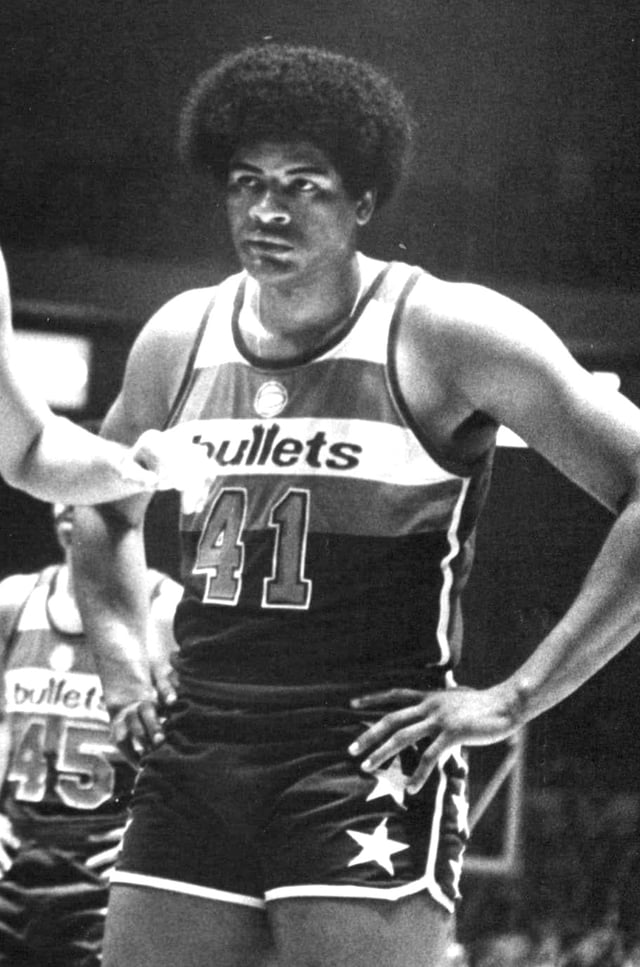
Wes Unseld, who won the NBA Rookie of the Year, NBA Regular Season MVP, and NBA Finals MVP awards, played all 13 seasons of his career with the Bullets.
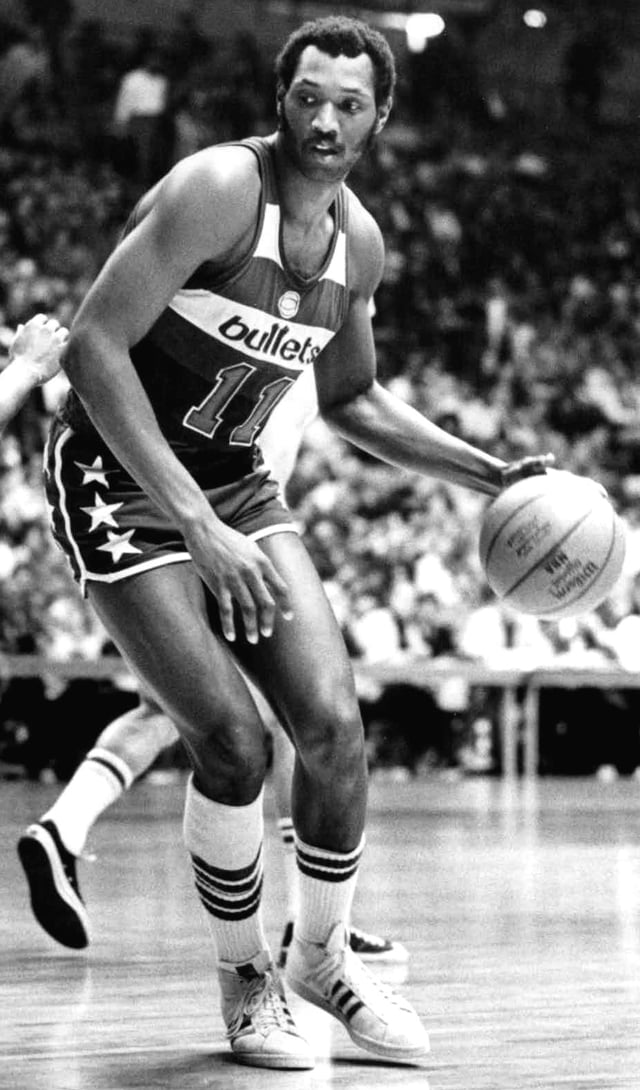
During his nine seasons with the Bullets, Elvin Hayes averaged 21.3 points per game and 12.7 rebounds per game. He led the NBA in rebounding in the 1973–74 season with an average of 18.1 rebounds per game.
In the late 1960s, the Bullets drafted two future Hall of Fame members: Earl Monroe, in the 1967 draft, number two overall, and Wes Unseld, in the 1968 draft, also number two overall. The team improved dramatically, from 36 wins the previous season to 57 in the 1968–69 season, and Unseld received both the rookie of the year and MVP awards. The Bullets reached the playoffs with high expectations to go far, but they were eliminated by the New York Knicks in the first round. The next season the two teams met again in the first round, and although this one went to seven games, the Knicks emerged victorious again.
In the 1970–71 season, the 42–40 Bullets again met the 1970–71 Knicks, this time though in the Eastern Conference finals. With the Knicks team captain Willis Reed injured in the finals, the injury-free Bullets took advantage of his absence, and in game seven, at New York's Madison Square Garden, the Bullets' Gus Johnson made a critical basket late in the game to lift the Bullets over the Knicks 93–91 and advance to their first NBA Finals. They were swept in four games by the powerful Milwaukee Bucks led by future Hall of Fame members Kareem Abdul-Jabbar (known in 1971 as Lew Alcindor) and Oscar Robertson.
Even after the trades of Earl Monroe (to the Knicks) and Gus Johnson (to the Suns), the Bullets remained a playoff contender throughout the 1970s. Following a less than spectacular 1971–72 season, Baltimore acquired Elvin Hayes from the Houston Rockets and drafted Kevin Porter in the third round, out of St. Francis in Pennsylvania.
After a slow start in 1972–73, Baltimore made their charge in December, posting a 10–4 record on the way to capturing the Central Division title for the third straight year. The Bullets again faced the Knicks in the 1973 NBA Playoffs, losing for the fourth time in five series against New York.
During November 1973, while waiting for the completion of their new arena in Landover, the Bullets played their home games at Cole Field House on the campus of the University of Maryland in College Park. The Capital Centre (later known as the USAir/US Airways Arena) opened on December 2, 1973, with the Bullets defeating the SuperSonics. Through the mid-1990s, the Bullets still played a few games per season in Baltimore.
The 60–22 Bullets made it back to the 1975 NBA Playoffs. That year, Washington posted a 36–5 home record at the Capital Centre. In the first round of the playoffs, they survived a seven-game series against the Buffalo Braves as both teams won all of their games at home. In the Eastern Conference finals, they beat the defending NBA champion Boston Celtics in six games to advance to the NBA Finals. The Bullets were favorites to win the NBA Championship, but were swept by the Al Attles-led Golden State Warriors in four games, losing games one and four at the Capital Centre.
The loss at the NBA Finals lingered into the 1975–76 season, as they won 12 fewer games than last year, and in the playoffs they were eliminated by the Cleveland Cavaliers in seven games. After the season, the Bullets fired head coach K.C. Jones, despite having a career 62% winning percentage as the Bullets head coach.
In 1976–77, under new head coach Dick Motta, the Bullets again fell short of the Central Division title for the second straight year. Elvin Hayes finished sixth in the league in rebounds with 12.5 rebounds per game. After opening the 1977 NBA Playoffs with a three-game series victory over the Cleveland Cavaliers, the Bullets took a 2–1 series lead in the second round against the Houston Rockets. With a chance to take a 3–1 series lead at home, the Bullets lost 107–103, and the Rockets took the series in six games.
1977–78 Championship season
Although they had future hall of famers Elvin Hayes and Wes Unseld on the team, the Bullets finished the 1977–78 season 44–38 and were a longshot to win the NBA Finals, but San Antonio journalist Dan Cook used the famed phrase "The opera ain't over 'til the fat lady sings". This became the rallying cry for the Bullets as they finished a playoff run that led to the NBA Finals, defeating the Seattle SuperSonics in seven games to bring a professional sports championship to Washington, D.C. for the first time in 36 years.
1978–79
In the 1978–79 NBA season the Bullets moved to the Atlantic Division, capturing the title in their first season there. They entered the 1979 NBA Playoffs having lost eight of the final 11 games to finish the regular season at 54–28. In the playoffs the Bullets nearly blew a 3–1 series lead against the Atlanta Hawks, but managed to hold off the Hawks in seven games.
In the Eastern Conference finals, they trailed the San Antonio Spurs 3–1, but they mounted a comeback by winning two straight games to force a game seven at the Capital Centre. The Bullets rallied again, overcoming a fourth–quarter deficit to beat George Gervin and the Spurs 107–105 in one of the NBA's all-time greatest games and advance to the NBA Finals and a rematch with the Seattle SuperSonics.
In game one of the finals, the Bullets defeated the SuperSonics, 99–97, on two game-winning free throws. They lost the next four games, and the series, to Seattle. The Bullets were the only team to play in the NBA Finals four times during the 1970s.
1979–1988: Playoff disappointments
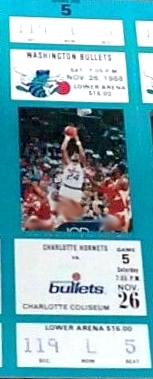
A ticket for a 1988–89 game between the Bullets and the Hornets.
Age and injuries finally caught up with the Bullets. In the 1979–80 NBA season, they barely made the playoffs as they captured the sixth and final playoff spot with tiebreaker despite posting a 39–43 record. In the playoffs, they were swept by the Philadelphia 76ers in a two-game playoff series. The following year the Bullets failed to make the playoffs for the first time in 13 years. Wes Unseld retired and Elvin Hayes was traded to the Houston Rockets the following season.
In 1980–81, Washington played strong under the coaching of Gene Shue and Don Moran, finishing the regular season with a 43–39 record, and although they advanced to the Eastern Conference semifinals in the playoffs, they had clearly lost their form of the late 1970s. The 1982 Bullets continued to play with the same talent they had in the previous year. They finished with a winning record, but in a highly competitive Atlantic Division they finished last and missed the playoffs.
The next two years saw the Bullets continue to play mediocre basketball as they finished with losing records but they made the playoffs in the new expanded NBA Playoffs format that involved the 16 best teams to make the playoffs; the Bullets were eliminated in both years in the first round.
In 1985, the Bullets acquired Manute Bol, whose specialty was blocking shots. That year, he blocked 397 shots (a Bullets record), part of a team that blocked 716 shots (a Bullets team record). But the Bullets finished with a disappointing 39–43 record, and were eliminated by the 76ers in the first round of the NBA Playoffs. The Bullets acquired center Moses Malone from the Philadelphia 76ers for center Jeff Ruland the following season for hope of improvement. Malone would lead the team in scoring with a 24.1 points per game as he would be joined by Jeff Malone who averaged 22.0 points per game. The Bullets' 42–40 record would be their last winning season until the 1996–97 NBA season. Washington was eliminated by the Detroit Pistons in 3 games in the playoffs.
The Bullets selected Muggsy Bogues twelfth overall in the 1987 Draft, who at 5'3" is the smallest player in NBA history. The Bullets would get off to a slow start as coach Kevin Loughery was fired 27 games into the season with the Bullets holding an 8–19 record. To replace Loughery, the Bullets hired former MVP Wes Unseld. Under Unseld the Bullets improved as they were able to reach the playoffs again with a record of 38–44. After losing the first 2 games on the road in the first round of the 1988 NBA Playoffs to the Detroit Pistons, the Bullets fought back and forced a 5th game with 2 home wins. They would lose game 5 by 21 points. It would be 9 years before Washington would return to the NBA Playoffs.
1989–1997
The Bullets got off to a 5–1 start in 1989, but they lost 16 of 18 games from mid-December to mid-January. They finished with a 31–51 record despite stellar seasons by Jeff Malone and Bernard King, who averaged 24.3 and 22.3 points per game respectively to lead the team.
The lone highlight of the Bullets 30-win 1990–91 season was the successful comeback effort by Bernard King as he recovered from knee surgery he suffered while playing for the Knicks in the 1984–85 NBA season to finish third in the NBA in scoring with a 28.4 points per game. In 1990, the team named Susan O'Malley as its president, the first female president of a franchise in the history of the NBA. Susan O'Malley is the daughter of Peter O'Malley, the prominent lawyer from Maryland and former president of the Washington Capitals.
The Bullets continued to struggle due to injuries and inconsistent play. They posted a 25–57 record in the 1991–92 season. Pervis Ellison was named 1992 Most Improved Player of The Year, averaging 20.0 points, 11.2 rebounds, and 2.7 blocks per game. Undrafted rookie Larry Stewart became the first undrafted player in NBA history to make an All-Rookie Team, being selected to the All-Rookie Second Team. The Bullets drafted Tom Gugliotta with their sixth overall pick in the 1992 NBA draft. They finished the 1992–93 season with a 22–60 record. Following the season, the Bullets traded Harvey Grant to the Portland Trail Blazers for former All-Star center Kevin Duckworth. In 1993, the Bullets did a rap music video of their version of Naughty by Nature's rap single "Hip Hop Hooray", featuring the rap trio themselves.
Injuries continued to bite the Bullets as key players Rex Chapman and Calbert Cheaney (the club's first-round draft pick) missed significant stretches, and Ellison missed almost the entire season. The result was a 24–58 record for the 1993–94 season. Don MacLean was named 1994 Most Improved Player of the season, leading the Bullets with 18.2 points per game (tied with Chapman).
The Bullets selected Juwan Howard in the 1994 NBA draft and traded Gugliotta along with three first-round draft picks to the Golden State Warriors for the rights to Chris Webber. While the season started out with promise, a shoulder injury to Chris Webber (ironically against the Warriors) caused him to miss 19 games and the Bullets struggled through the rest of the season finishing a then franchise-worst (percentage wise) 21–61. Webber averaged 20.1 points and 9.6 rebounds per game, but declined surgery for his dislocated shoulder. This would prove costly for the next season. The Bullets released a holiday video, "You da Man, You da Man, that's the reason I'm a Bullets Fan!" in 1994, which featured all 12 Bullets dancing in front of the Reflecting Pool in Washington, D.C.[11][12][13]
In the Bullets' 1995–96 season Webber suffered a dislocated left shoulder in a preseason game against the Indiana Pacers on October 21, and opened the season on the injured list. He was activated on November 27, but strained his shoulder against the New York Knicks on December 29. After hoping the injury would get better with rest, Webber finally underwent surgery on Feb 1 which sidelined him for the remainder of the season. The Bullets were 9–6 with Webber in the lineup as he averaged a team-high 23.7 points plus 7.6 rebounds, 5.0 assists and 1.80 steals in 37.2 minutes per game when he was able to play. Other players injured included Mark Price (who only played in 7 games) and Robert Pack (31 games played out of 82). Bright spots of the season included the selection of Rasheed Wallace in the 1995 NBA draft and the All-Star play of Howard. Howard averaged a career-best 22.1 ppg and 8.1 rpg and kept the Bullets slim playoff hopes alive until the end of the season. Center Gheorghe Mureșan was named Most Improved Player of The Year, averaging 14.5 points, 9.6 rebounds, and 2.3 blocks. The Bullets improved to 39–43 but just missed the playoffs for the eighth consecutive season.
Washington, boasting the league's tallest player (Mureșan, whose height is 7 ft 7 in), two very athletic forwards (Howard and Webber) and one of the league's top point guards (Rod Strickland), started the 1996–97 season at 22–24. That led to the dismissal of head coach Jim Lynam. Bernie Bickerstaff, an assistant coach with the Bullets when they won their only NBA Championship in 1978, was called upon to resurrect his former team. The Bullets responded, winning 16 of their final 21 games to finish 44–38, their best record since 1978–79. The late surge enabled the Bullets to climb within reach of the Cleveland Cavaliers for the final playoff spot in the Eastern Conference. In a win-or-go-home game with the Cavaliers on the season's final day, the Bullets squeezed past Cleveland 85–81 to end the franchise's longest playoff drought. And while the Bullets were swept by the Bulls in the first round, they lost the three games by a total of 18 points.
Webber led the way in scoring (20.1 ppg), rebounding (10.3) and blocks (1.9) and shot 51.8 percent from the floor to make his first All-Star team. Howard averaged 19.1 ppg and 8.0 rpg, while Strickland averaged 17.2 ppg and 1.74 spg and finished fifth in the league in assists with 8.9 per game. Mureşan dominated the middle and led the NBA in field goal percentage (.599). Washington received contributions from Calbert Cheaney (10.6 ppg) and Tracy Murray (10.0 ppg).
Becoming the Wizards
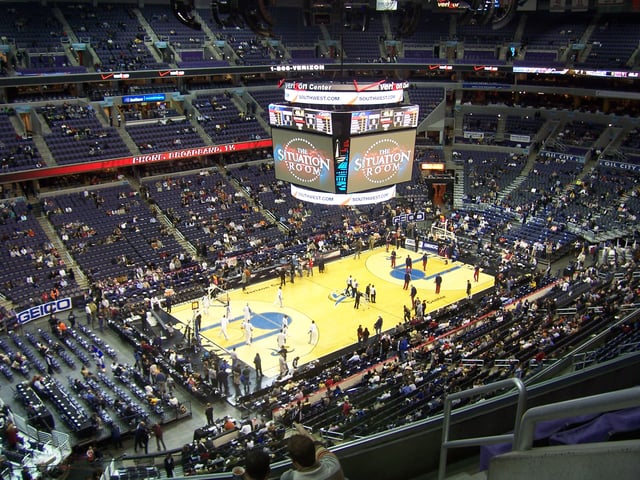
The Wizards moved to the MCI Center (later named Verizon Center and now the Capital One Arena) in 1997.
In November 1995, owner Abe Pollin announced he was changing the team's nickname,[14] because Bullets had acquired violent overtones that had made him increasingly uncomfortable over the years, particularly given the high homicide and crime rate in the early 1990s in Washington, D.C. The name change was widely believed to be related to the assassination of Pollin's longtime friend, Israeli Prime Minister Yitzhak Rabin.[15]
A contest was held to choose a new name and the choices were narrowed to the Dragons, Express, Stallions, Sea Dogs, and the Wizards.[16] On May 15, 1997, the Bullets officially became the Wizards. The new name generated some controversy because "Wizard" is a rank in the Ku Klux Klan, and Washington has a large African American population.[16] A new logo was unveiled and the team colors were changed from the traditional red, white and blue to a lighter shade of blue, black and bronze, the same colors as the Washington Capitals of the National Hockey League (NHL), also owned by Pollin. That same year the Wizards moved to the then MCI Center, now called Capital One Arena, which is home to the Capitals, the Washington Mystics of the Women's National Basketball Association and the Georgetown Hoyas men's college basketball team.
In 1998, they became the brother team to the Mystics, and remained officially thus until 2005 when the Mystics were sold to Lincoln Holdings (headed by Ted Leonsis), parent company of the Capitals. However, upon the purchase of the Wizards by Leonsis in 2010, the Wizards and Mystics again became sibling teams.
1997–2001
The newly named Wizards began the 1997–98 season playing 5 home games at the Capital Centre before moving to the new MCI Center on December 2, 1997. The Wizards finished the season with a 42–40 record including 4 straight victories to end the season but just missed the playoffs. Highlights of the season included Chris Webber leading the team in scoring (21.9 ppg) and rebounding (9.5 rpg). Strickland led the league in assists (10.5 apg) before suffering an injury near the end of the season. He was also named on the All-NBA Second Team. Tracy Murray averaged 15.1 ppg off the bench including a 50-point game against Golden State. Off court distractions led to the trade of Webber to the Sacramento Kings for Mitch Richmond and Otis Thorpe in May 1998.
The Wizards finished the lockout shortened season of 1998–99 with a record of 18–32. Mitch Richmond led the team in scoring with a 19.7 ppg average. In the 1999–2000 season, the Wizards finished with a 29–53 record. Mitch Richmond led the team with 17.4 ppg. In the 2000–2001 season, under newly hired coach Leonard Hamilton, 1999 NBA draft pick Richard Hamilton led the team in scoring with 18.1 ppg, but the team finished with a 19–63 record (a franchise low).
On February 23, 2001, the Wizards were involved in a blockbuster trade days before the trading deadline. The team sent Juwan Howard, Obinna Ekezie and Calvin Booth to the Dallas Mavericks. In return, Washington received Hubert Davis, Courtney Alexander, Christian Laettner, Loy Vaught and Etan Thomas along with $3 million.
2001–2003: Michael Jordan era
2001–02
After retiring from the Chicago Bulls in early 1999, Michael Jordan became the Washington Wizards' president of basketball operations as well as a minority owner in January 2000. In September 2001, Jordan came out of retirement at age 38 to play for Washington. Jordan stated that he was returning "for the love of the game." Because of NBA rules, he had to divest himself of any ownership of the team. Before the All-Star break, Jordan was one of only two players to average more than 25 points, 5 assists, and 5 rebounds[17] as he led the Wizards to a 26–21 record. After the All-Star break, Jordan's knee could not handle the workload of a full-season as he ended the season on the injured list, and the Wizards concluded the season with a 37–45 record.
2002–03
Jordan announced he would return for the 2002–03 season, and this time he was determined to be equipped with reinforcements, as he traded for All-Star Jerry Stackhouse and signed budding star Larry Hughes. Jordan even accepted a sixth-man role on the bench in order for his knee to survive the rigors of an 82-game season. A combination of numerous team injuries and uninspired play led to Jordan's return to the starting lineup, where he tried to rebound the franchise from its early-season struggles. By the end of the season, the Wizards finished with a 37–45 record once again. Jordan ended the season as the only Wizard to play in all 82 games, as he averaged 20.0 points,[18] 6.9 rebounds, 3.8 assists, and 1.5 steals in 37.0 minutes per game. Jordan retired from playing for a third and final time after the season.[19]
Jordan's departure
After the season, majority owner Pollin fired Jordan as team president, much to the shock of players, associates, and the public. Jordan felt betrayed, thinking that he would get his ownership back after his playing days ended, but Pollin justified Jordan's dismissal by noting that Jordan had detrimental effects on the team, such as benching Hughes for Tyronn Lue, making poor trades, and using the team's first-round draft pick on high schooler Kwame Brown. The Wizards replaced Jordan's managerial role with general manager Ernie Grunfeld.
2003-2019: Ernie Grunfeld's tenure
2003–2010: Gilbert Arenas era
2003-04
Without Jordan in the fold the following year, the Washington Wizards were not expected to win, and they did not. Despite the signing of future All-Star point guard Gilbert Arenas, in a move that was ironically made possible by Jordan's prior cap-clearing maneuvers as a team executive, the team stumbled to a 25–57 record in the 2003–04 season. Following the season, Jerry Stackhouse, Christian Laettner, and a first-round draft pick (which turned out to be University of Wisconsin–Madison point guard Devin Harris) were all traded to the Dallas Mavericks for Antwan Jamison.
2004–05: Return to the playoffs
The 2004–05 NBA season saw the team (now in the new Southeast Division) post its best regular-season record in 26 years (45–37) and marked the first time the franchise had ever made the playoffs as the Wizards. In the off-season, the team traded Stackhouse, Christian Laettner, and the draft rights to Devin Harris to the Dallas Mavericks for Antawn Jamison. During the regular season, the scoring trio of Arenas, Jamison and Hughes was the highest in the NBA and earned the nickname of "The Big Three". Hughes led the NBA in steals with 2.89 per game. Arenas and Jamison were both named to the 2005 Eastern Conference All-Star team, marking the first time Washington had two players in the All-Star game since Jeff Malone and Moses Malone represented the Bullets in the 1987 All-Star Game.
With a 93–82 win over the Chicago Bulls on April 13, 2005, the Wizards clinched a playoff spot for the first time since 1996–97.[20] Long-suffering fans celebrated by buying over 16,000 playoff tickets in two and a half hours the day tickets went on sale.[21] In game 3 of the first round against the Bulls, the Wizards won their first playoff game since 1988.[22] Adding to the "long-overdue" feeling was the fact that game 3 was the first NBA playoff game to be held within Washington, D.C. city limits.[23] In the Wizards' game 5 victory in Chicago, Arenas hit a buzzer-beater to win the game[24] and the Wizards took their first lead in a playoff series since 1986. In Game 6 at the MCI Center, Jared Jeffries picked up a loose ball and went in for an uncontested tie-breaking dunk with 32 seconds left, thus giving the Wizards a 94–91 win and the team's first playoff series win in 23 years. They were only the 12th team in NBA history to win a playoff series after being down 0–2.[25]
In the conference semifinals, the Wizards were swept by the Miami Heat, the No. 1 seed in the Eastern Conference in the 2005 NBA Playoffs.
2005–06
The 2005–06 NBA season was filled with ups and downs. During the off-season, Washington acquired Caron Butler and Antonio Daniels. During the regular season, the Wizards again had the best scoring trio in the NBA, this time consisting of Arenas, Jamison and Butler as the "Big Three". The Wizards started the 2005–06 season at 5–1, but went on an 8–17 funk to go to 13–18 through 31 games. Then, they went 13–5 in the next 18 games. On April 5, 2006, the team was 39–35 and looking to close in on the 45-win mark achieved the previous year, until Butler suffered a thumb sprain and the Wizards lost all five games without him. Butler returned and the team pulled out their final three games, against the Pistons, Cavs and Bucks, all playoff-bound teams, to finish the year at 42–40 and clinch the 5th seed in the Eastern Conference. They averaged 101.7 points a game, third in the NBA and tops in the East and clinched a playoff berth for the second year in a row for the first time since 1987.
Their first-round match-up with Cleveland was widely seen as the most evenly matched series in the 2006 NBA Playoffs. The teams exchanged wins during the first two games in Cleveland, with Game 2 highlighted by the Wizards holding LeBron James to 7–25 shooting from the floor while Brendan Haywood gave James a hard foul in the first quarter that many cited as the key to shaking up the rest of James's game. In Game 3 at the Verizon Center, James hit a 4-footer on the way down with 5.7 seconds left to take the game and the series lead for the Cavs with a 97–96 win. Arenas missed a potential game-winning three-pointer on the other end to seal the win for the Cavs. Game 4 saw the Wizards heat up again, as Arenas scored 20 in the fourth quarter after claiming he changed his jersey, shorts, shoes and tights in the room and the Wizards won 106–96. Yet in Games 5 and 6, the Cavs would take control of the series, both games decided by one point in overtime.
In Game 5, despite the Wizards being down 107–100 with 1:18 to play, the team drove back and eventually tied the game on Butler's layup with 7.5 seconds remaining to send the game to OT, where James scored with 0.9 seconds left in overtime to send the Cavs to a 121–120 win. The series returned to the Verizon Center for Game 6, where the game went back and forth all night. The Wizards blew a 14-point first-quarter lead, then for 24 minutes, from early in the second quarter to early in the fourth, neither team led by more than five points at any time. The Wizards blew a seven-point lead with just under 5 to play and needed Arenas to hit a 31-footer at the end of regulation to take the game to overtime. In OT, Arenas missed two key free throws. Cleveland rebounded the ball, went downcourt and Damon Jones hit a 17-foot baseline jumper with 4.8 seconds remaining to give the Cavs the lead for good. Butler missed a three-pointer on the other end to seal the game, and the series, for the Cavaliers.
2006–07
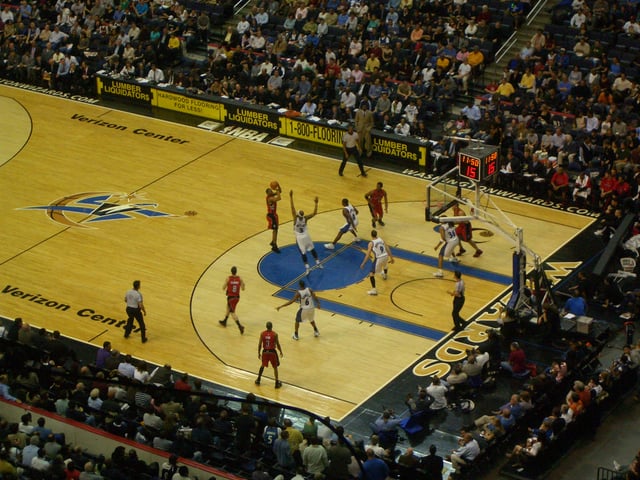
The Wizards in a home game against the Toronto Raptors, March 30, 2007.
The 2006–07 season started out very promisingly for the Wizards. In the off-season they signed free agents DeShawn Stevenson and Darius Songaila. Etan Thomas beat out Haywood for the starting center job. After starting the season 0–8 on the road, Washington rebounded to win 6 of 7 away from Verizon Center. After a November 4–9, Washington went 22–9 through December and January. Arenas scored a franchise-record 60 points against the Lakers on December 17. He and Eddie Jordan were named player of the month and coach of the month for December, respectively. On January 3 and again on January 15, Arenas hit buzzer-beating three-pointers to beat Milwaukee and Utah.
On January 30, Jamison went down with a sprained left knee in a win against Detroit. Washington went 4–8 in the 12 games without him. On February 3, Songaila made his Wizards debut against the Lakers. On February 18, Eddie Jordan became the first Wizards/Bullets coach to coach the NBA All-Star Game since Dick Motta in 1978–1979. Arenas played in his third straight All-Star game and Butler made his All-Star Game debut.
On March 14, Butler went out with a knee injury that kept him out of the lineup for six games. He returned for only three games until he fractured his right hand on April 1 against Milwaukee. On April 4, Arenas suffered a season-ending knee injury, of the meniscus. An April 15 article in The Washington Post pointed out that with Arenas and Butler gone, the team had lost 42.3% of their offensive production, quite possibly "the most costly" loss for any team in the midst of a playoff hunt in NBA history.[26]
Despite their late-season struggles without Arenas and Butler, the Wizards still managed to make the Eastern Conference playoffs, taking the 7th seed at 41–41. They were swept four games to none in a rematch of the previous year's first-round series against the Cleveland Cavaliers. Despite a depleted roster, the Wizards still managed to keep things close in every game in the series and only lost the final three games by a combined 20 points. The team enjoyed their best attendance figures in the post-Jordan era with a season attendance of 753,283 (18,372 per game).[27]
2007–08
The Wizards retained a majority of their roster from the 2006–07 season, only losing Jarvis Hayes to Detroit, Calvin Booth to the Philadelphia 76ers, and Michael Ruffin to the Milwaukee Bucks as free agents. Washington signed Oleksiy Pecherov, the team's first-round pick in 2006, as well as 2007 picks Nick Young and Dominic McGuire. Etan Thomas missed the regular season after undergoing open-heart surgery.
The team began the season starting 0–5, but rebounded to win six straight. After 8 games, Arenas underwent surgery to repair a torn medial meniscus in his left knee, as well as a microfracture surgery. This was the same knee he had injured the previous year. The injury forced Arenas out for a total of 68 games. Midway through the season, Butler was forced to the sidelines for a total of 20 games with what initially was a strained hip flexor, but turned out to be a labral tear. Despite all of the injuries, the Wizards managed to go 43–39 on the regular season, good for 5th place in the Eastern Conference and a first-round playoff matchup with the Cleveland Cavaliers for the third straight season.
2008–10
During the off-season, Arenas signed a 6-year, $111 million contract, while Jamison signed a 4-year, $50 million contract. The Wizards did not re-sign guard Roger Mason, who signed with the San Antonio Spurs. The Wizards added guards Dee Brown and Juan Dixon, and drafted JaVale McGee 18th overall[28] in the 2008 NBA Draft.
In September, Arenas underwent a third operation on his surgically repaired left knee to clean out fluid and debris, and was expected to miss at least the first month of the season. The forecast came in longer than expected, as Arenas missed 5 months of action due to concerns on his knee before returning on March 29, 2009. In the first game of the preseason, Jamison suffered a right knee contusion, and was expected to miss the rest of the preseason. Haywood announced that he would undergo surgery on his right wrist and was expected to miss 4–6 months. The preseason marked the return of Etan Thomas who had missed all of the 2007–2008 season while recovering from open heart surgery. The Wizards added guard Fenny Falmagne from the Dakota Wizards on August 23, 2008 that later was waived by the team after knee injury.
The Wizards opened the season on October 29 with a loss against New Jersey, and dropped 15 of their first 19 games. Head coach Eddie Jordan was fired on November 24 after a 1–10 start, and was replaced by interim coach Ed Tapscott. On December 10, Washington acquired guards Javaris Crittenton and Mike James in a three-team deal that sent Antonio Daniels to New Orleans. The team waived guard Dee Brown. They won just 14 of their first 60 games and in the end tied a franchise worst record of 19–63.
One of the few high points of the season came on February 27 when recently inaugurated President Barack Obama attended a Wizards game against the Chicago Bulls, sitting in a northeast court-side seat. The Wizards produced their second-biggest victory margin of the season with a 113–90 win; Jamison paced the side with 27 points.
On April 2, the Wizards shut down the Cleveland Cavaliers, who came in with a record of 61–13, and ended Cleveland's franchise-best winning streak at 13.
Flip Saunders reached an agreement to become the new coach of the team in mid-April 2009.[29] Despite having the second best chance at obtaining the number one overall pick in the 2009 draft, the Wizards were randomly chosen to pick fifth overall in the NBA Draft Lottery.[30] This pick was later traded to the Minnesota Timberwolves, along with Songaila, Thomas, and Oleksiy Pecherov, in exchange for Randy Foye and Mike Miller.[31] On May 21, 2009, Wizards president Ernie Grunfeld announced that the team has named Randy Wittman and Sam Cassell as assistant coaches.[32] Then on August 11, 2009, the Wizards signed Fabricio Oberto, many weeks after he committed to signing with the team.[33]
On December 24, 2009, it was revealed that Arenas had admitted to storing unloaded firearms in his locker at Verizon Center and had surrendered them to team security. In doing so, Arenas violated both NBA rules against bringing firearms into an arena and D.C. ordinances.[35] On January 1, 2010, it was reported that Arenas and teammate Javaris Crittenton had unloaded guns in the Wizards' locker room during a Christmas Eve argument regarding gambling debts resulting in Arenas's suspension.[36] Despite Stern's longstanding practice of not disciplining players until the legal process plays out, he felt compelled to act when Arenas's teammates surrounded him during pregame introductions prior to a game with the Philadelphia 76ers and he pantomimed shooting them with guns made from his fingers.[37] The Wizards issued a statement condemning the players' pregame stunt as "unacceptable".[38]
On February 13, 2010, after a 17–33 record at the season's midway point, The Wizards traded Butler, Haywood, and Stevenson to the Mavericks in exchange for Josh Howard, Drew Gooden, Quinton Ross and James Singleton. Three days later, the Wizards traded Antawn Jamison to the Cavaliers in exchange for Zydrunas Ilgauskas and obtained Al Thornton from the Los Angeles Clippers in a three-team deal. Ilgauskas reported long enough to take a physical (to make the trade official). His contract was immediately bought out, making him a free agent. On February 26, 2010, the Wizards signed Shaun Livingston to a 10-day contract. With Gilbert Arenas suspended and Caron Butler and Antawn Jamison being traded, the Wizards finished the season at 26-56, posting an abysmal 9–23 record to finish the season. They were the only Southeast Division team not to make the post-season.
2010–2019: John Wall era
2010-13: beginning of John Wall era
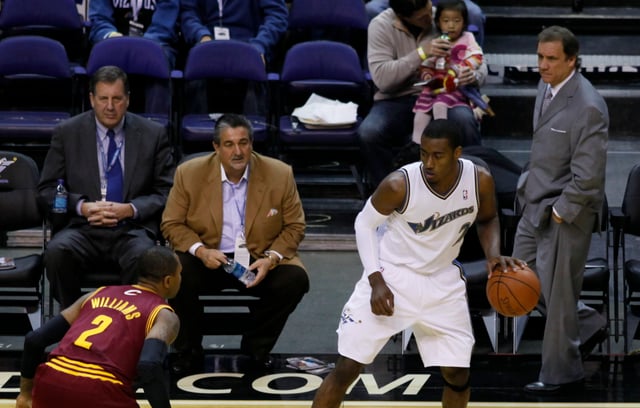
Owner Ted Leonsis and then coach Flip Saunders watch John Wall in 2010.
Leonsis completed his takeover of the Wizards and Verizon Center in June through his newly-formed holding company, Monumental Sports and Entertainment.[39] He had previously purchased the Washington Capitals and Mystics from the Pollin family.[40] Leonsis has taken a fan-centric approach to running the franchise, by listening and responding to the concerns of Wizards supporters through his email and personal website.[41] He has written a manifesto of 101 changes he hopes to implement during his ownership, including changing the team's colors back to the red, white and blue of the Bullets era, and possibly changing the team nickname back to 'Bullets' as well.[41] Team president Ernie Grunfeld later confirmed that the franchise's colors would revert to red, white and blue from the 2011–12 season onwards. The team also adopted new uniforms that were very similar to the ones they wore from 1974 to 1987. Although the Wizards did not change their name to the Bullets again, they adopted a variation of the 1969–1987 Bullets logo with "wizards" spelled in all lowercase letters like the "bullets" logo was printed.[42]
Despite having only the 5th-best odds of obtaining the No. 1 pick (10.3% overall), the Wizards won the 2010 NBA draft lottery and selected All-American Kentucky point guard John Wall with the first overall pick.[43] Later in the offseason, the team acquired the Chicago Bulls' all-time leader in three-point field goals, Kirk Hinrich and the draft rights to forward Kevin Seraphin in exchange for the draft rights to Vladimir Veremeenko.
In a blockbuster trade, the Wizards sent Gilbert Arenas to the Orlando Magic in return for Rashard Lewis on December 18. Kirk Hinrich and Hilton Armstrong were traded to the Atlanta Hawks for Jordan Crawford, Maurice Evans, Mike Bibby, and a 2011 first-round pick that became Chris Singleton, although Mike Bibby bought out his contract after playing two games and eventually signed with the Miami Heat. The Wizards finished with a 23–59 record, once again occupying the Southeast Division cellar.
After a poor start to the 2011–12 season, head coach Flip Saunders was fired and replaced by assistant Randy Wittman.[44] On March 15, the Wizards were involved in a three-way trade that sent JaVale McGee and Ronny Turiaf to the Nuggets and Nick Young to the Clippers in exchange for Nenê and Brian Cook. After ending the season on a six-game win streak, the Wizards finished with a record of 20-46 (season was shortened due to the 2011 NBA Lockout) and the second worst record in the NBA, comfortably ahead of the 7-59 Charlotte Bobcats who set a new NBA record for the lowest win percentage in a season with .106.
The Wizards sent Rashard Lewis and a pick to the Hornets for Emeka Okafor and Trevor Ariza.
In the 2012 NBA Draft, the Wizards selected Bradley Beal and Tomáš Satoranský. On July 17, 2012, the Wizards exercised the amnesty provision from the 2011 CBA to release Andray Blatche.[45] They also signed A. J. Price. Then, on August 29, 2012, Martell Webster was signed to the Wizards for one year on a $1.6 million contract. He played above average for what he was signed for and had a .422 average for three-pointers and a .442 field goal percentage. On April 30, 2013. Jason Collins, who joined the team in February announced his homosexuality as a member of the Wizards. His announcement made him the first openly gay member of a North American team sport.
On May 21, 2013, the Wizards jumped up 5 spots in the NBA Draft Lottery to make the number 3 overall selection for the second year in a row.[46] They used that pick to draft Consensus All-American Otto Porter of Georgetown University.[47] On October 25, 2013, Wizards' center Emeka Okafor and a top-12 protected 2014 first-round pick were traded to the Phoenix Suns for the center Marcin Gortat, Shannon Brown, Malcolm Lee and Kendall Marshall.[48]
2013-14: Return to playoffs
On February 3, 2014, the Wizards defeated the Portland Trail Blazers to improve to a 24–23 record. The win marked the first time the team had held a winning record since 2009.[49]
On April 2, 2014, the Wizards defeated the Boston Celtics by a score of 118–92 to clinch the team's first playoff berth since the 2007–08 season.[50] On April 29, 2014, the Wizards defeated the Chicago Bulls in game 5 of the Eastern Conference Quarterfinals by a score of 75–69 to win the series 4–1. This was the Wizards first series victory since the 2005 NBA Playoffs when they defeated the same team in 6 games.[51] The Wizards advanced to the Eastern Conference semi-finals against the Indiana Pacers. The Wizards won game one 102–96. In game two the Wizards lost a 19-point second half lead, as they dropped the game 88-82. After being routed by Indiana in game three 85-63, they also lost game four 95-92. They showed grit and determination as they staved off elimination with a 102–79 game five win. They were behind most of game 6, but battled back to take the lead late in the game. However, Indiana closed out the series with a 93–80 win. Trevor Ariza would leave in the offseason.
2014-15
After the departure of Trevor Ariza, the Wizards signed veteran small forward Paul Pierce to a two-year contract. Pierce's veteran leadership proved to be a major factor on and off the court in the team's improvement. On November 12, 2014, the Wizards defeated the Detroit Pistons 107–103, extending their record to 6–2 for the first time since the 1975–76 season.[52] The following game three days later, the Wizards defeated the Orlando Magic 98-93 as they won their third straight and moved to 7–2, their best start since opening 7–1 during the 1974–75 season.[53] With a 104–96 win over the Los Angeles Clippers on December 12, the Wizards moved to an 11–2 record at home to start the season for the first time in franchise history.[54] They would struggle throughout the later months of the season but the Washington Wizards would finish the season with a 46–36 record, their best record since the 1978–1979 season. They played the Toronto Raptors in the first round of the NBA Playoffs and won in four games, marking their first sweep in franchise history. Following the victory over Toronto, the Wizards next had to play the top seeded Atlanta Hawks. The Wizards managed to take the first game in the series, but suffered the loss of Wall due to a fractured wrist. Although small forward Paul Pierce made several big shots throughout the series, the loss of Wall proved too much, and Atlanta took the series in six games.
2015-16
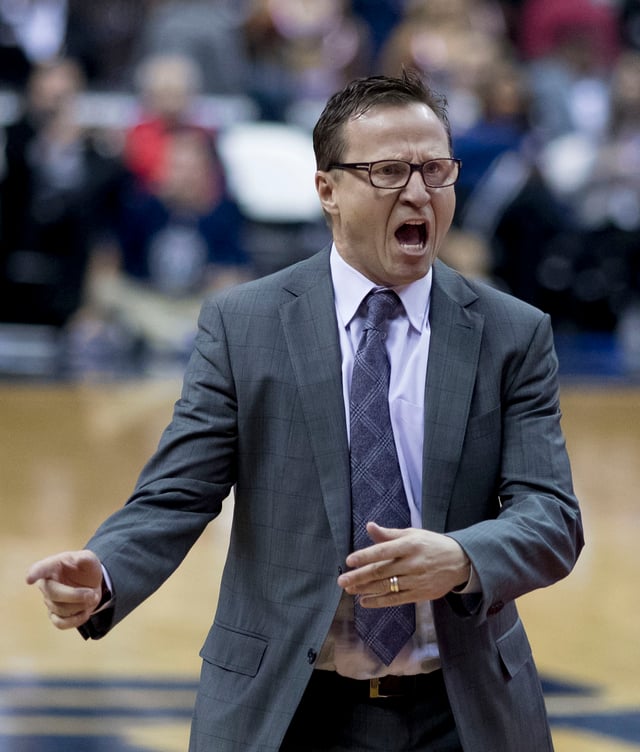
Scott Brooks is the current head coach.
On April 21, 2016, Scott Brooks, the former head coach of the Oklahoma City Thunder, agreed to a 5-year, $35 million deal to be the head coach of the Wizards.[57] On September 8, 2016, the team unveiled new alternative jerseys.[58] From 2015 on, their logo was the "monument ball" with "Navy Blue, Red, Silver, White" colors.[59] In October 2016, they were ranked 93rd of 122 worst franchises in major sports by Ultimate Standings.[60]
2016-17
The Wizards started off the 2016–17 season with a 2–8 record. However, they rebounded to touch the second seed, before a slump brought them down to the fourth seed, finishing 49–33, behind the 51–31 Toronto Raptors at third, the 51–31 Cleveland Cavaliers at second, and the 53–29 Boston Celtics in first place. The Wizards won their division title for the first time since the 1978–79 season, also clinching home-court advantage for the first time since the 1978–79 season, and the team had their best record since the 1978–79 season. The Wizards played the fifth-seeded Atlanta Hawks in the first round of the Eastern Conference playoffs, defeating them in six games behind a 42-point game six performance from Wall and 31 from Beal; before losing to the Boston Celtics in a seven-game series.
2017-18
2018-19
In the off season, they picked up Thomas Bryant off waivers and Troy Brown in the draft with the 15th pick in the 2018 NBA Draft. Desptie Bryant becoming a valuable asset and Bradley Beal having a career season, the season would end up being a underwelming one full of turmoil and on court troubles. The Wizards also went through injuries, including Dwight Howard playing 9 games before missing the rest of the season due to back problems and losing John Wall who underwent a season-ending surgery on his left Achilles which he injured while recovering from a previous injury, while trading Kelly Oubre Jr., Otto Porter Jr., and Markieff Morris at the same time. As a result, the Wizards would miss the playoffs for the first time since the 2015–16 season. On April 2019, the Wizards fired general manager Ernie Grunfeld, who had been with the team since 2003, with Tommy Sheppard taking over as interim general manager until being officially hired fulltime in July 2019.[63][64]
2019-present: Rebuilding
Along with making Tommy Sheppard the general manager, and with other front office moves, the Wizards selected Japanese player Rui Hachimura with their 9th pick in the 2019 NBA Draft as well as acquiring the Philadelphia 76ers draft rights to 42nd pick Admiral Schofield in a trade. [65]
Season-by-season records
Team name, logos and uniforms

Washington Wizards G-Wiz, current team mascot
After moving from Chicago in 1963, the then-Baltimore Bullets used red and navy colors as part of the team's logos and uniforms. In 1969, the club changed the colors to blue and orange. The red, white and blue colors returned as part of the franchise's iconic uniforms beginning with the 1973–74 season, coinciding with the team's move to Landover, Maryland to become the Capital Bullets. Those uniforms also featured large horizontal stripes on the chest of the jerseys, and three stars on the side panels of the shorts. The uniforms were kept when they changed their name a year later to the Washington Bullets.[66]
In 1997, the then-team owner Abe Pollin decided to change the club's nickname from Bullets to Wizards. The reasoning behind the name change was because Pollin did not want the team's name to continue to be associated with any violent connotations.[67] The name change also included new logos, colors and uniforms, coinciding with the team's move to the new MCI Center. The new team's colors were blue, bronze and black. The primary logo depicted a wizard conjuring a basketball with a quarter moon. In 2007, the Wizards made minor modifications on their team jerseys and logos. To accommodate the gold–black alternate jerseys they introduced the previous season along with the design change on the Verizon Center floor, they changed their secondary team colors from bronze to metallic gold, and the player's name on the back of the jersey was changed from white/blue with bronze trim to gold (blue on home uniforms) with a change in lettering.
On May 10, 2011, the Wizards unveiled a new color scheme, uniforms, and logo. David Safren, Pat Sullivan, and Michael Glazer were the product designers for the new jerseys which include the Washington Monument as an alternate logo. The team of product designers was led by Jessie Caples, who made most of the design decisions. James Pinder was also an essential part of the team, as he helped to engineer the jerseys to meet the players' standards. The team reverted to its traditional red, white and blue colors, which are the colors of the U.S. flag. The uniforms are based very closely on those worn from 1974 to 1987, during the team's glory years. Leonsis said the throwback to the old Bullets' uniforms was intentional; the only difference between those uniforms and the current ones is the team name on the jerseys. The colors were also used by Leonsis' other franchises, the Capitals and the Mystics, who adopted to those colors in 2007 and 2011, respectively.[4]
On July 23, 2014, the Wizards unveiled a new alternate uniform. The uniform is similar to the club's road set, with the navy and red colors switched, so that navy is the predominant color instead of red.[68]
On April 15, 2015, the Wizards unveiled a new primary logo. The new logo features the Washington Monument ball logo set in a roundel, with the striping pattern from the team's uniforms, three stars (each representing Washington, D.C., Maryland, and Virginia, similar to that of the NHL's Capitals), and the team's wordmarks.[69][70] The team also said it would immediately discontinue the use of the wizard/partial moon logo, which had been used since 1997.
On September 30, 2015, the Wizards unveiled a new alternate uniform. Called the "Baltimore Pride" uniform, the uniform is intended to be worn for six select games during the Wizards' 2015–16 season.[71]
Home arenas
International Amphitheatre (1961–1962)
Chicago Coliseum (1962–1963)
Baltimore Civic Center (later the Baltimore Arena, and 1st Mariner Arena now Royal Farms Arena) (1963–1973, occasional games in 1990s)
US Airways Arena (originally Capital Centre) (1973–November 1997)
Capital One Arena (formerly MCI Center and Verizon Center) (December 1997–present)
Players
Current roster
Washington Wizards roster | ||||||||||||||||||||||||||||||||||||||||||||||||||||||||||||||||||||||||||||||||||||||||||||||||||||||||||||||||||||||||||||||||||||||
|---|---|---|---|---|---|---|---|---|---|---|---|---|---|---|---|---|---|---|---|---|---|---|---|---|---|---|---|---|---|---|---|---|---|---|---|---|---|---|---|---|---|---|---|---|---|---|---|---|---|---|---|---|---|---|---|---|---|---|---|---|---|---|---|---|---|---|---|---|---|---|---|---|---|---|---|---|---|---|---|---|---|---|---|---|---|---|---|---|---|---|---|---|---|---|---|---|---|---|---|---|---|---|---|---|---|---|---|---|---|---|---|---|---|---|---|---|---|---|---|---|---|---|---|---|---|---|---|---|---|---|---|---|---|---|
| Players | Coaches | |||||||||||||||||||||||||||||||||||||||||||||||||||||||||||||||||||||||||||||||||||||||||||||||||||||||||||||||||||||||||||||||||||||
|
Roster [78] Last transaction: 2019–07–14 | |||||||||||||||||||||||||||||||||||||||||||||||||||||||||||||||||||||||||||||||||||||||||||||||||||||||||||||||||||||||||||||||||||||
Head coaches
Retained draft rights
The Wizards hold the draft rights to the following unsigned draft picks who have been playing outside the NBA. A drafted player, either an international draftee or a college draftee who is not signed by the team that drafted him, is allowed to sign with any non-NBA teams. In this case, the team retains the player's draft rights in the NBA until one year after the player's contract with the non-NBA team ends.[72] This list includes draft rights that were acquired from trades with other teams.
| Draft | Round | Pick | Player | Pos. | Nationality | Current team | Note(s) | Ref |
|---|---|---|---|---|---|---|---|---|
| 2018 | 2 | 44 | Issuf Sanon | G | Cedevita Olimpija (Slovenia) | [73] |
Retired numbers
| Washington Wizards retired numbers | ||||
| No. | Player | Position | Tenure | Retired |
|---|---|---|---|---|
| 10 | Earl Monroe | G | 1967–19711 | December 1, 2007 |
| 11 | Elvin Hayes | F | 1972–19812 | |
| 25 | Gus Johnson | F | 1963–19721 | December 13, 1986 |
| 41 | Wes Unseld | C3 | 1968–19814 | 1981 |
| 45 | Phil Chenier | G5 | 1971–19796 | March 23, 2018 |
Notes:
1 All in Baltimore
2 1972–1973 in Baltimore
3 Also served as coach (1987–1994)
4 1968–1973 in Baltimore
5 Also served as Bullets/Wizards television color analyst (1984–2017)
6 1971–1973 in Baltimore
Basketball Hall of Famers
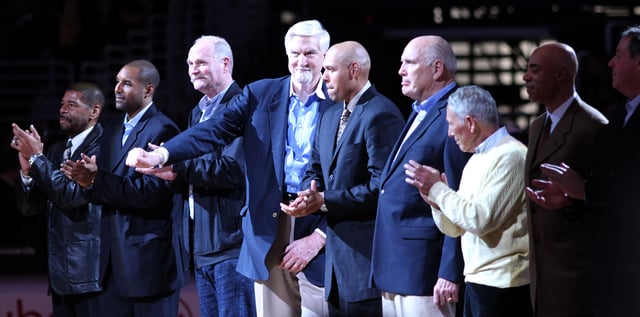
Former Bullets players honored during a Wizards game in March 2012 at the Verizon Center
| Washington Wizards Hall of Famers | ||||
|---|---|---|---|---|
| Players | ||||
| No. | Name | Position | Tenure | Inducted |
| 41 | Wes Unseld1 | C/F | 1968–1981 | 1988 |
| 10 33 | Earl Monroe | G | 1967–1972 | 1990 |
| 11 | Elvin Hayes | C/F | 1972–1981 | 1990 |
| 21 | Dave Bing | G | 1975–1977 | 1990 |
| 8 | Walt Bellamy2 | C | 1961–1963 | 1993 |
| 15 | Bailey Howell | F/G | 1964–1966 | 1997 |
| 4 | Moses Malone | C/F | 1986–1988 | 2001 |
| 23 | Michael Jordan3 | G/F | 2001–2003 | 2009 |
| 25 | Gus Johnson | F/C | 1963–1972 | 2010 |
| 50 | Ralph Sampson | C/F | 1991 | 2012 |
| 30 | Bernard King | F | 1987–1991 | 2013 |
| 2 23 | Mitch Richmond | G | 1998–2001 | 2014 |
| 24 | Spencer Haywood | F/C | 1981–1983 | 2015 |
| Coaches | ||||
| Name | Position | Tenure | Inducted | |
| Bobby Leonard4 | Head coach | 1962–1964 | 2014 | |
| Contributors | ||||
| Name | Position | Tenure | Inducted | |
| 44 | Rod Thorn5 | G | 1963–1964 | 2018 |
Notes:
1 He also coached the team in 1987–1994.
2 In total, Bellamy was inducted into the Hall of Fame twice – as player and as a member of the 1960 Olympic team.
3 In total, Jordan was inducted into the Hall of Fame twice – as player and as a member of the 1992 Olympic team.
4 He also played for the team in 1961–1963.
5 Thorn was inducted as a contributor.[74]
FIBA Hall of Famers
| Washington Wizards Hall of Famers | ||||
|---|---|---|---|---|
| Players | ||||
| No. | Name | Position | Tenure | Inducted |
| 23 | Michael Jordan | G/F | 2001–2003 | 2015 |
| 21 | Fabricio Oberto | C | 2009–2010 | 2019 |
Individual records and awards
Franchise leaders
Bold denotes still active with team.
Italic denotes still active but not with team. Points scored (regular season) (as of the end of the 2018–19 season)[75]
Elvin Hayes (15,551)
Jeff Malone (11,083)
John Wall (10,879)
Wes Unseld (10,624)
Kevin Loughery (9,833)
Gus Johnson (9,781)
Phil Chenier (9,778)
Bradley Beal (9,684)
Walt Bellamy (9,020)
Gilbert Arenas (8,930)
Antawn Jamison (8,736)
Greg Ballard (8,706)
Juwan Howard (8,530)
Jack Marin (8,017)
Earl Monroe (7,775)
Bernard King (6,516)
Kevin Grevey (6,442)
Caron Butler (5,889)
Jeff Ruland (5,653)
Harvey Grant (5,445)
Other statistics (regular season) (as of the end of the 2018-19 season)[75]
Individual awards
NBA All-Star weekend
NBA All-Star Game
| Three-Point shootout
|
